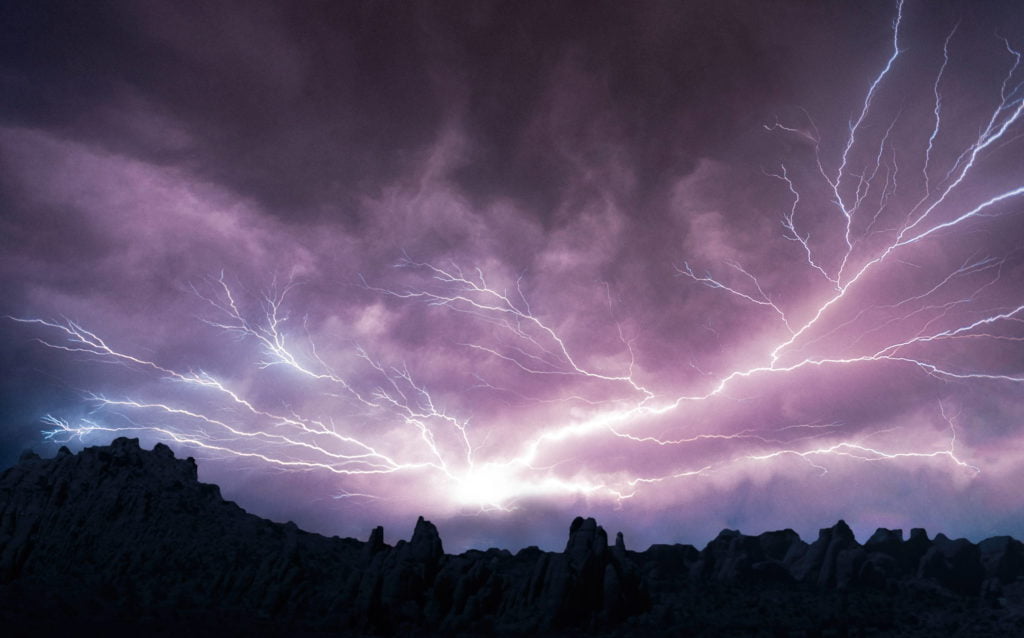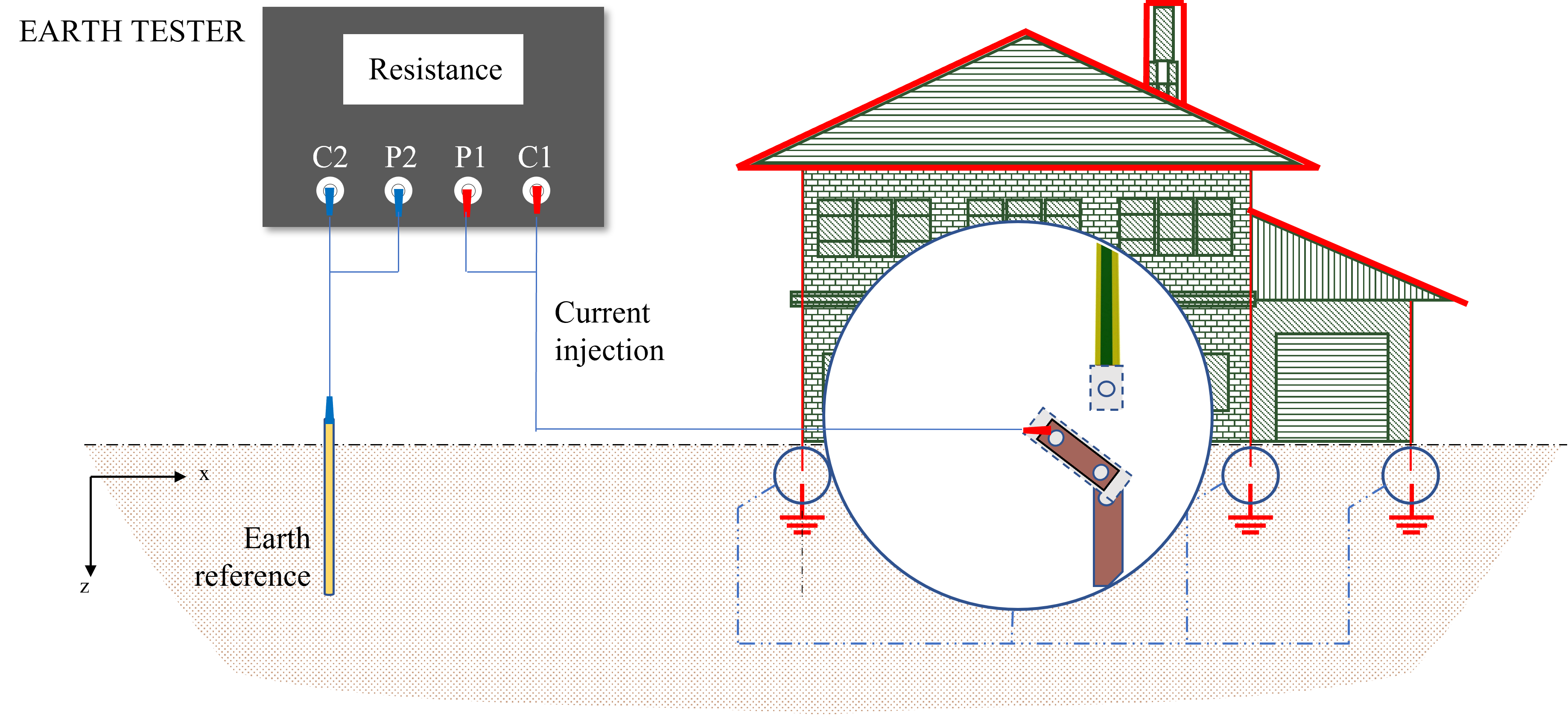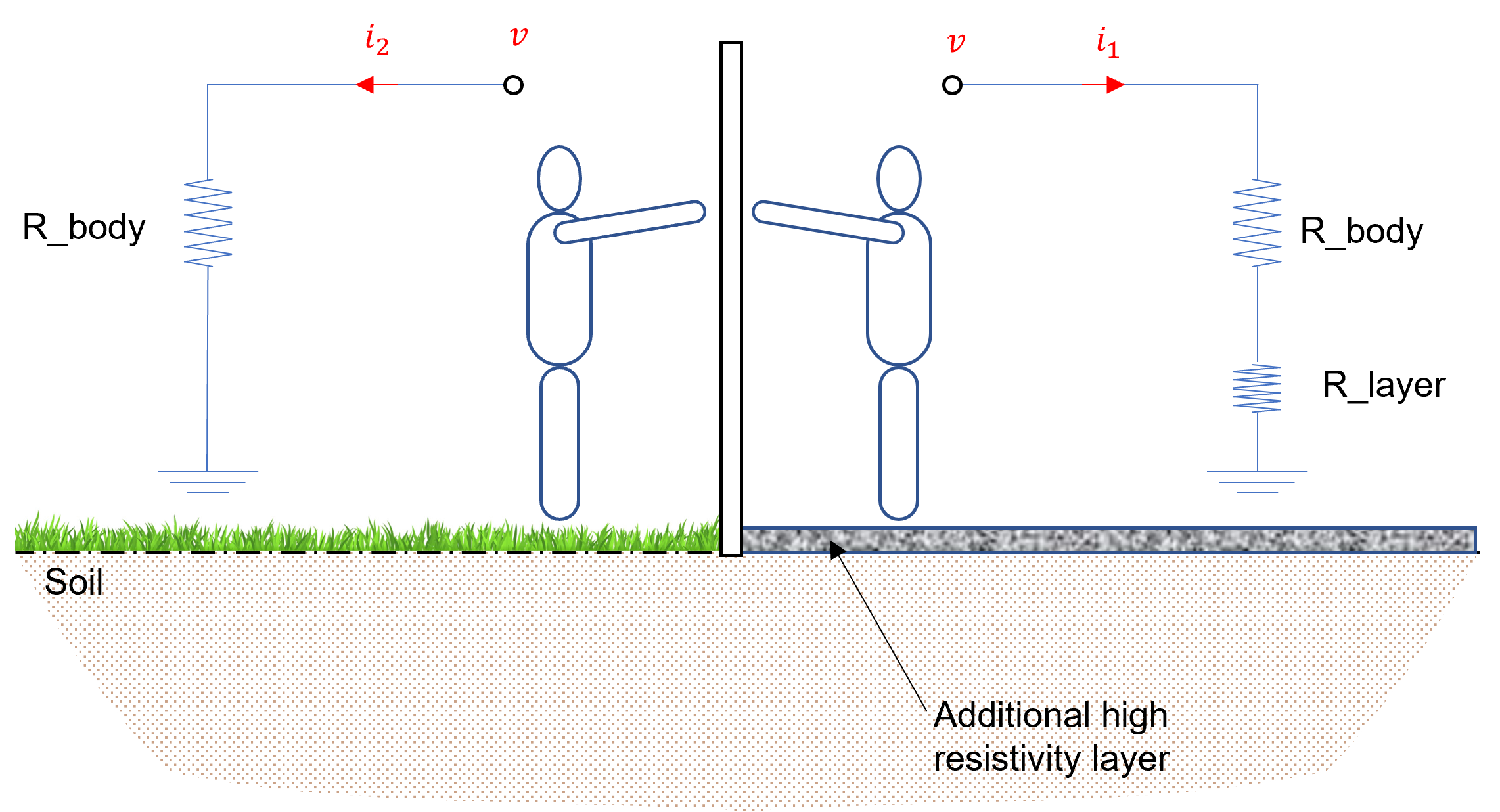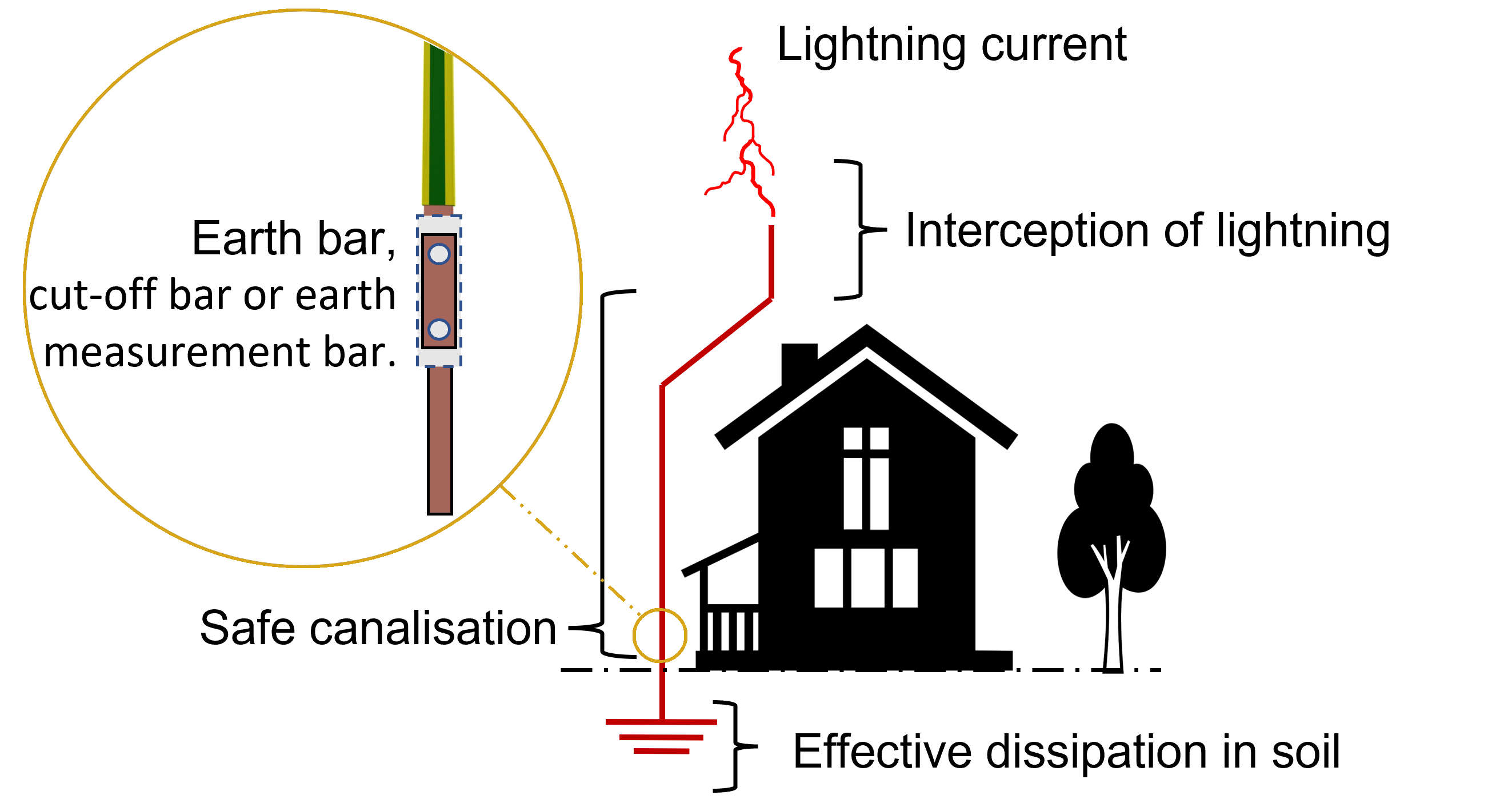“Safety is something that happens between your ears, not something you hold in your hands.”
—Jeff Cooper
Lightning is one of the leading cause of death from natural disasters, behind only floods and earthquakes as the deadliest phenomena in the world. To reduce your chances of getting struck by lightning, plan ahead so that you can get to a safe place quickly.
How do we stay safe if the sky appears threatening or if we hear thunder? Once inside, what are the steps and precautions that must be considered to stay safe? How to ensure that we are in a safe place?
Overview On Lightning Protection
Lightning Protection Strategy
In achieving the protection of any objects against lightning, the typical strategy is to capture or attract the lightning at a selected point by means of air terminations, and conducting its unnecessary energy directly to the earth through earth electrodes (with a resistance of less than ten ohms) via low impedance down conductors.
Role of Lightning Protection Systems
A lightning protection system is mainly designed and implemented to protect structures from fire and/or mechanical destruction and people inside the buildings from any injury or even from death. Lightning protection is based on the installation of devices which will, on the one hand, ensure the control of the connection of lightning on the structures, and evacuate its energy to the earth (Franklin rod type lightning rods, mesh cages or shielding), and on the other hand, to limit the electromagnetic disturbances of lightning, by the implementation of a set of measures allowing the control of the rise in potential of the grounds and the masses and their clipping by surge protection devices. At this stage, it is necessary to take into consideration all the modes of transmission of electromagnetic disturbances caused by lightning (electric lines, telephone lines, cables, metal pipes, the ground itself, the air, etc.). A lightning protection system consists of external and internal lightning protection systems.
External and Internal Lightning Protection Systems
External lightning protection systems are installed to intercept direct lightning strikes via an air-termination system, safely conduct the lightning current to the ground via a down-conductor system, and finally to distribute the lightning current in the ground via an appropriate earthing system. Therefore, a basic and typical lightning protection system consists of:
- Air terminal or air termination system (lightning rods or strike termination devices),
- Bonding conductors,
- Earth terminals or earthing systems (e.g., earthing rods, plates, or mesh)
- Connectors for the measurement.
Figure 1 illustrates a typical representation of an external lightning protection system. In this protection, two air terminals are used where the house is inside the protection zone as indicated by the dash-dotted line.
On the other hand, internal lightning protection system is mainly established to prevent any dangerous sparking inside the structure. This is achieved by creating equipotential bonding or keeping a separation distance between the components of the lightning protection system and other electrically conductive elements inside the structure.
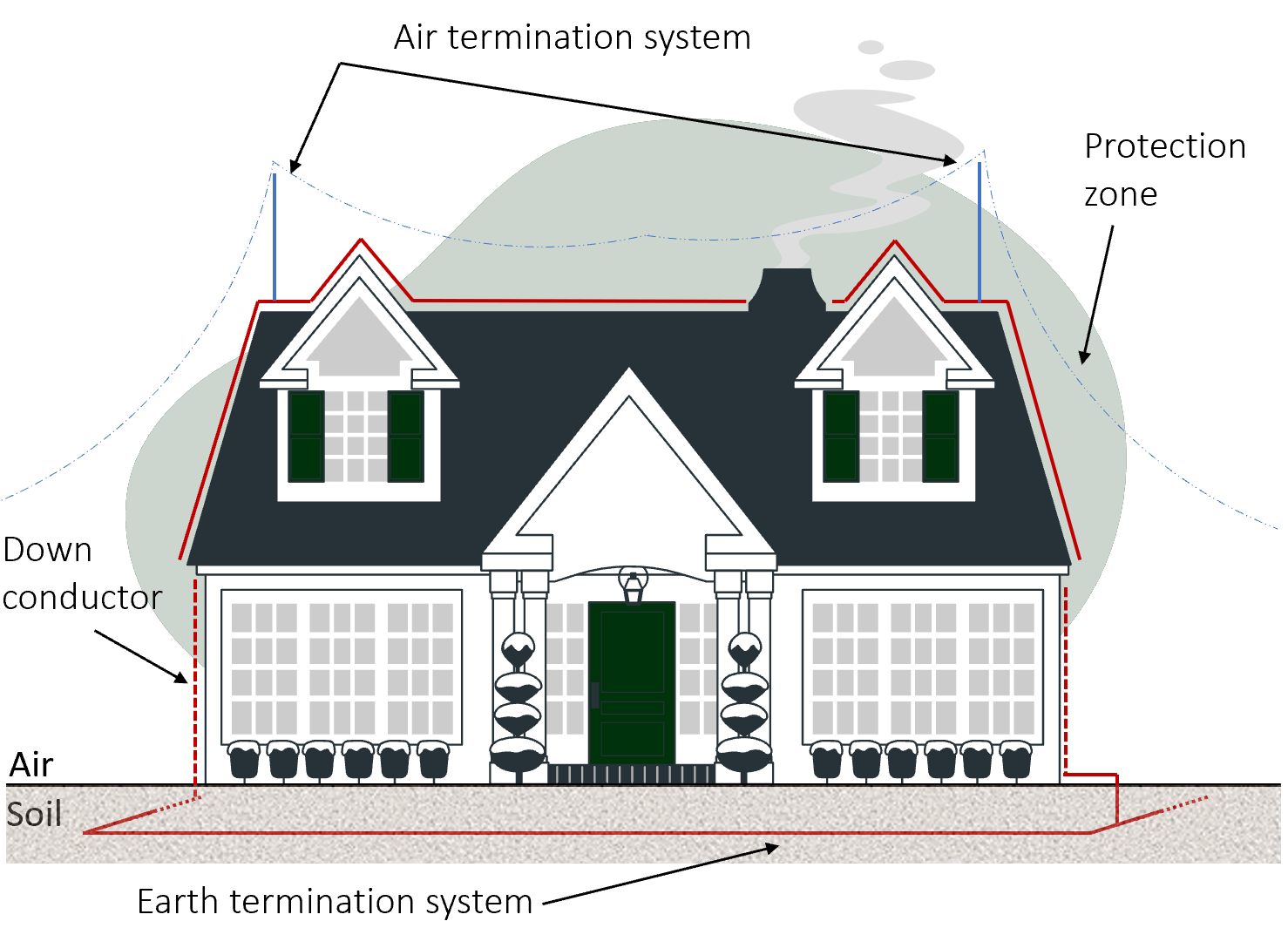
Lightning Protection System (LPS) Design Considerations
The analysis and implementation of LPSs require more expertise as the risks and their associated costs increase. To be effective, these protection systems must be studied from the design of structures and buildings. Device maintenance and verification procedures must also be put in place. A LPS is based on established standards for risk assessment, and is designed according to multiple factors and parameters such as the geographical location, local terrain, soil conditions, size and height of building, type of material used in construction, type of material stored in the building, use of building and so on.
A comprehensive risk assessment needs to be carried out prior to the design of the structural LPS to determine the class of LPL required based on the IEC/BS EN 62305 standards for the UK, or other internationally accepted standards.
The determination of the connection points of the lightning discharge has been based for a long time on the examination for relations between the assembly distance of a lightning discharge by a structure referenced on the ground and one or more characteristics of the discharge and/or the structure. These are the electrogeometric models as shown in Figure 2. These models aim to geometrically dimension the protection devices and measure their effectiveness.
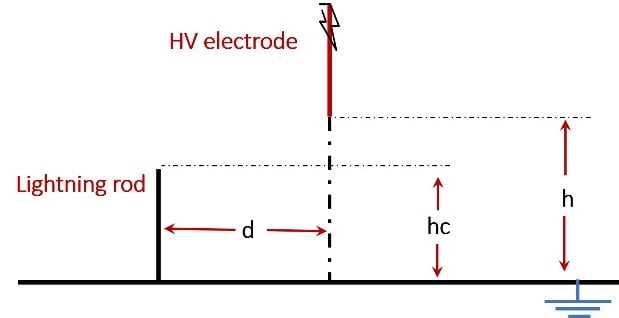
This figure illustrates a basic electro-geometrical model used to verify the attraction zone of lightning rods. The preliminary lightning discharge (tracer by jumps), just before the final jump, is simulated by a conductive copper rod, placed under a high voltage negative lightning shock, which is -1.2/50 µs waveform type (normalized lightning discharge current). The relation in question can be physical, empirical, or semi-physical and can be expressed in the form of simplified formulas, charts, or even calculation programs.
The principle of the electrogeometric model was developed in the years 1970 to 1980 with the main objective of studying the protection of overhead lines for the transmission of high and very high voltage electrical energy.
It led to the development of a relationship between the distance “d” of lightning capture by a structure and the intensity “I” of the arc current in return.
Electrogeometric models are currently used to design and size protections by guard cables, taut threads, or captor points.
Surge Protection
LPSs are designed, as fire protection systems, to protect the building from burning down and reducing the hazard presented to the people and equipment inside. Appropriate LPSs are constructed according to the standards where Surge Protection Devices (SPDs) should be added at every entrance of building service conductors, providing a complete protection on circuits associated with electrical, communication, and/or data lines that can transmit lightning into a structure. Hence, it is necessary to install a surge arrester in the electrical panel to protect the electrical circuits and equipment of a home from the danger of lightning.
For building entrances, Surge Protection Devices (SPDs) are designed to ride the line, sense overvoltage, and then send unnecessary energy directly to the earth. SPDs are different for lightning surges because they should respond immediately to the onset of the first rise time waveform, typically within a few nanoseconds. In addition, they should be able to sustain the connection to the earth through the severe overvoltage incident, then reset to their monitoring role.
Each SPD is individually designed for each system and for a given function. This is due to the fact that they are sized for various systems that operate at different voltages. SPDs should be accessible for view, and usually have indicator lights to ensure that the protection continues as designed.
Risk Prevention of Work at Height During Storms
Meteorological phenomena cannot be prevented, but they are increasingly predicted by meteorological services which issue warnings and the risks of suffering serious consequences can be mitigated by individual and collective risk prevention measures.
Lightning Detectors
A lightning detector is a device that detects lightning induced by thunderstorms, before it hits the earth. It includes different systems that use direction finding tools, as well as using specific frequencies emitted by lightning to find the estimated direction and intensity of lightning.
Lightning Risk Analysis
The design and sizing of an external lightning protection device is governed by standards such as BS EN 62 305 and NF C 17-100, which propose a risk analysis method based on parameters such as the sensitivity of an installation (presence of hazardous materials, risk of panic, etc.) and its exposure to the lightning phenomenon, estimated from lightning strike statistics for the geographical area in which the installation to be protected is located.
This analysis leads to the determination of a level of protection to be provided and from which the standard proposes an adequate dimensioning of the external protection device of the installation and identifies the equipment for which protection must be ensured.
Depending on the results of the lightning risk analysis, a technical study is carried out by a competent body, precisely defining the prevention measures and protection devices, the location of their installation, as well as the methods of their verification and control. their maintenance.
Lightning Risk Assessment Software
Several lightning risk assessment software are available to design offices, and some lightning professionals have developed their own software. These software avoid doing iterative calculations of probabilistic methods manually. Such software must take into account the complexity of the structures and the optimization of risk reduction measures.
Protecting Yourself From Lightning Using A Few Basic Rules
Electrification, burns, fires, falling objects … among the natural risks, thunderstorms can have serious consequences. How to avoid being struck by lightning? How to react in the event of an accident? Discover all the prevention tips in the following parts:
Outdoor Safety
Lightning usually strikes outdoors. Certain precautions make it possible to reduce the risk of these flashes. The first safety measure is to check the weather forecast before undertaking any outdoor activity, and to avoid going out during a thunderstorm.
The recommendations are then based on two principles:
- Do not be a target for lightning;
- Avoid all situations which risk creating a difference in electrical potential between two parts of the body.
If a thunderstorm occurs while you are outdoors:
- Stay away from any metal structure, pylons, fences, in order to avoid possible touching tension;
- Take shelter in a vehicle or a house.
- Do not stay under a tree, a group of trees, a cave, an isolated hut or a telephone booth.
If you cannot take shelter, spread an insulating material on the ground. In the absence of insulating material, lying down, legs folded under you or on the chest remains the position of least risk.
It is not recommended to stand with your legs apart or to walk with great strides when you are in a thunderstorm. There is a risk of concussion or electrocution by a “step voltage”.
In open space, do not carry any object, in particular metallic, which emerges above your head: fork, scythe, golf club … Likewise, never take cover under an open umbrella. On the contrary, any conductive part must be lowered or placed on the ground. If you are in a group, move at least three meters apart from each other to avoid the risk of side flash.
In the mountains, move away from the summit as soon as you see lightning or hear thunder. Descend at least 30 meters below the highest point. Stay away from any wall, squatting or sitting on an insulation element as dry as possible, knees bent and feet together.
Indoor Safety
Lightning protection begins before a thunderstorm. Paying attention to weather conditions and forecasts will give you the time you need to plan for your retreat in the face of threatening weather and to react appropriately. A safe building is the safest place to find shelter during a thunderstorm. A safe building is completely enclosed by a roof, walls and a floor, and electrical wiring, plumbing, telephone line or antennas are grounded to prevent lightning striking the building directly.
Even indoors, certain security measures must be taken.
- Choose where there are the most walls between you and the outside.
- Stay away from doors, windows, fireplaces.
- Keep away from any electrically conductive object, such as radiators, stoves, sinks, pipes and metal pipes.
- Use only battery-powered devices.
It is well-known that lightning can strike a home or its surroundings, and affect its occupants, especially through the telephone line. For this purpose, avoid using a landline phone during a thunderstorm (except in an emergency). If the line is struck by lightning, the resulting surge can spread over several kilometers. The mobile phone on the other hand is here without risk.
The only way to eliminate any risk inside is to have an “equipotentialisation” carried out, that is to say to interconnect all the metal parts. This operation prevents any overvoltage in the electrical circuit. It can only be carried out by an approved surge arrester installer. In general, the first solution to protect a home is to install a lightning rod on the roof. This external protection device allows current to be diverted to earth through the earthing system.
In a home without a surge arrester, avoid touching metal parts such as water pipes and taps, as well as household appliances during a thunderstorm, even if the building has a lightning rod. It is also recommended to unplug the mains plug from the TV antenna cable in the event of a thunderstorm, and place it at least one meter away from the set. The television set can indeed “implode” during a strong surge. It is also advisable to unplug the computers and any other electrical device.
How to React to A Lightning Accident?
The first thing you have to do is to call the emergency services. Then, check the victim’s condition. If the victim is breathing, put them in the lateral safety position (PLS).
Note that touching the victim does not expose you to any danger. Be aware that lightning can cause a fire to start.
Employers and supervisors should know and tell workers which buildings to go to after hearing thunder or seeing lightning.
If safe building structures are not accessible, employers should guide workers to hard-topped metal vehicles with rolled up windows.
Cranes are not lightning-proof. The lightning bolt is attracted by metal conductors, like cranes, which become an enormous lightning collector.
The crane operator in his cabin is more or less protected by the Faraday cage of his cabin but, without a surge arrester at the top, he is not protected for the currents circulating in the various networks and which enter the cabin. The simplest protection, therefore, consists in installing a lightning rod with a single rod at the top in order to capture lightning and then conduct it to earth.
With over 325 meters tall, the Eiffel Tower can be considered as a giant lightning rod, which receives an average of 5 lightning strikes per year.
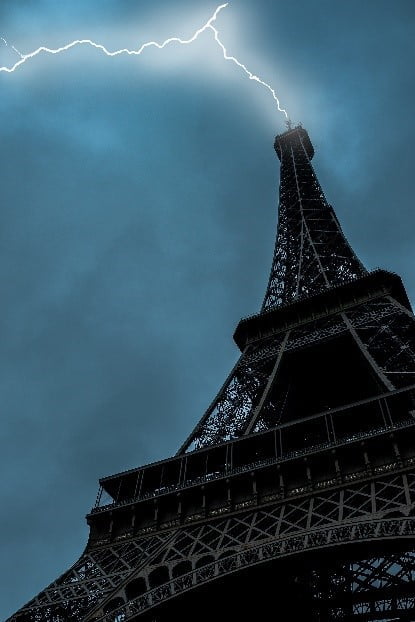
1. M. A. Uman. Natural Lightning, IEEE Transactions on Industry Applications, vol. 30, no. 3, May/Jun 1994
2. A. Haddad and D. Warne, Advances in High Voltage Engineering (Power & Energy), IET 2004.
3. Ritenour AE, Morton MJ, McManus JG, Barillo DJ, Cancio LC. Lightning injury: A review. Burns. Vol. 34, no. 5, 2008
4. BS EN/IEC 62305 Lightning protection standard
5. Vernon Cooray, Lightning Protection, IET Digital Library ,2009
6. V. A. Rakov and F. Rachidi, “Overview of Recent Progress in Lightning Research and Lightning Protection,” in IEEE Transactions on Electromagnetic Compatibility, vol. 51, no. 3, pp. 428-442, Aug. 2009
7. D. W. Zipse, “Lightning protection systems: advantages and disadvantages,” in IEEE Transactions on Industry Applications, vol. 30, no. 5, pp. 1351-1361, Sept.-Oct. 1994
8. Lightning Safety When Working Outdoors (Occupational Safety and Health Administration (OSHA))
9. Massimo Mitolo, Analysis of Grounding and Bonding System, Taylor & Francis Group, LLC 2020.
10. G. Vijayaraghavan, Mark Brown and Malcolm Barnes, Practical Grounding, Bonding, Shielding and Surge Protection, IDC Technologies, 2004.

